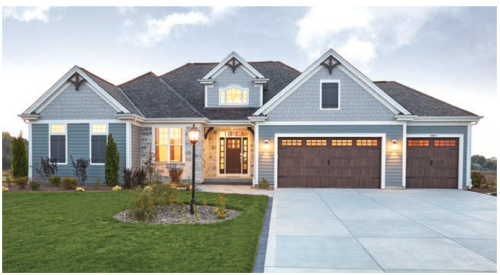Bold and arguably brilliant, Pulte Homes’ $1.7 billion purchase of Del Webb Corp. this year vaulted it to the top spot in the industry in terms of closings.
The deal is bold because Pulte had been growing mostly through internal means, dispensing with acquisitions in favor of building new markets from the ground up. It is bold also because Pulte deviated radically from its traditionally conservative balance sheet to add $950 million in debt from Del Webb.
The brilliance of the merger is easier to see. With active-adult leader Del Webb in the fold, Pulte can truly move forward with its "Homeowner for Life" strategy - offering buyers the opportunity to own a Pulte home at every stage of their lives. But this win-win outcome was far from view in the fall of 2000 when Del Webb faced a hostile takeover by a group of outside investors. Friends were few and far between.
With wolves at the door, Del Webb CEO LeRoy Hanneman and executive vice president Anne Mariucci received a call from Pulte chairman and CEO Bob Burgess. He wanted to express Pulte’s support during Webb’s tough proxy fight. Such was the state of Wall Street’s infatuation with dot-com that shares in home building companies, particularly Webb, had sunk to levels that left them vulnerable to hostile takeover.
Mariucci, now president of Pulte’s Del Webb Group (Hanneman has left the company), looks back at that phone call as a turning point.
"During that time, CEOs from each of the top 10 builders were trying to find their angle in a spirited, competitive way," she says, "but certainly not looking to do us any favors.
"There was simply one exception. Bob Burgess called us and said, ‘This can’t be any fun. We are behind you 100%. We want you to win. And all of our shareholders that we have in common, we have told them that you guys are on the right track. And if at any point in time there is anything that we can do to help, call us.’ That was not the message from any others. That was a very early and very strong signal of the integrity that this organization has and therefore the commonality that it has with our values."
About 60 days later, Hanneman and Mariucci called Burgess. Webb had succeeded in its proxy fight, but as the company looked to adjust its debt-heavy balance sheet, its options were limited by a lack of financing alternatives.
"But for Bob’s behavior 60 days before, there is no way that we would have picked up the phone," Mariucci says. "But because of that, we did. Pulte was the only suitor that we talked to with any level of seriousness."
And so began the merger of two home building Giants that at the time could list their similarities on the back of a matchbook cover. While Webb was characterized by its command-and-control, spare-no-expense style, Pulte prides itself on its highly decentralized, entrepreneurial structure. While Webb sales professionals pioneered relationship selling, Pulte’s sales staff is more likely to view everyone who walks through the sales-center door as a ready buyer.
Yet complementary operations abound. Pulte is in the midst of a national branding campaign, and through this merger it added two of the best-known brands in home building: Del Webb and Sun City. Despite its Homeowner for Life initiative, Pulte’s age-targeted and age-restricted units were fledglings compared with its robust first-time and move-up buyer segments, so Webb’s portfolio made Pulte the active-adult leader overnight. While Pulte is a technology leader of supply chain efficiencies and other business-to-business applications in the home building industry, Webb leads all others in electronic lead tracking and most areas of the business-to-consumer side of technology.
Pulte’s chief financial officer, Roger Cregg, indicates that the 4-month-old marriage is progressing well from a financial standpoint even though Del Webb was carrying $950 million in debt on July 31, when the deal closed. This merger would not have been possible without Pulte’s strong cash position.
It was "win-win" for both sides, Mariucci says.
Mark O’Brien, Pulte’s president and chief operating officer, concurs. He says the merger works well for Pulte from three strategic standpoints: the experience of the people who manage the Del Webb way, the brands and the Del Webb communities, "which are all in their first trimester" of buildout. "It is clearly not just about assets."
Making It Work
Statistics on mergers are bleak. Two-thirds of all mergers fail, points out Mike O’Brien, Pulte’s senior vice president/corporate development, because not enough attention is paid to the softer cultural issues. One reason PB editors selected Pulte as Builder of the Year was its chances of long-term success in integrating the two companies and its clear view of the challenge.
Mike O’Brien says all in the organization must be "on their guard" during the next 12 months to ensure that further integration progresses smoothly. "We are now entering the insidious time," he says. "It is just like a marriage. Just before the marriage, everyone is on his or her best behavior. Then you get married, and everyone goes back to being themselves."
Soon after this marriage was complete, those differences became clear, and Pulte executives proceeded with caution. On an extended road show to Del Webb communities, the more they saw, the more they realized the diversity of disciplines involved in the day-to-day work of operating the typical Sun City or Anthem community.
"We did not think our guys were ready," Mike O’Brien says about the five regional Pulte presidents who are given broad authority to run their groups. "We saw that Webb was building and selling houses, but they were doing a whole heck of a lot more. They have food service. They have baseball fields. Our guys would have probably gone in and taken a lot of cost out, but at the risk of ruining the brand. So we decided to leave them separate for now and see how far we can take this in terms of getting best practices in place in Del Webb, to get to know the business and visit the question of integration [within Pulte’s geographic divisions] maybe a year or two out."
For now, Del Webb is the largest of six Pulte divisions. But Mariucci and her team will not be alone in their effort to build trust between the organizations as well as to find commonality on cultural issues. The plan calls for a lot of cross-pollination, with Webb people moving to the Pulte side and vice versa.
Aiding this process will be stepped-up use of the Pulte training and mentoring program, Top Gun. Webb executives, as well as sales and construction personnel, will be trained to train others in the Pulte way. Another tool in the process will be the conversion of Webb’s straightforward compensation system to Pulte’s incentive-laden program by the end of this year.
A planned road show to Del Webb communities will roll out the new compensation plan, "but we are going to do it in the context of the whole cultural piece," Mike O’Brien says. "We are doing it in a more formal orientation so that we can gain some alignment and give them some grounding, anchors that they can hold on to. The compensation program supports our culture, the owner/operator kind of mind-set."
To that end, Mariucci coined a word to describe the new Del Webb, "corporapreneurial," a blending of command-and-control corporate-ness with a heavy dose of entrepreneurial spirit. She points out that much of what is planned for Del Webb was already in the works when the companies agreed to merge.
For example, she says, the strategy of offering developed lots in Webb’s country-club and family communities to selected builders to increase sales velocity has not changed except that now those outside builders have been replaced by Pulte regional or division presidents.
Also ongoing but now enhanced is the strategy of further leveraging the Del Webb and Sun City brands beyond their strength in the Southwest. Mariucci is enthusiastic about the opportunities for small (less than 1,000 acres), midsize (between 1,000 and 3,000 acres) and large (3,000-acre plus) active-adult communities in other population centers.
"The real leverage for us on the Del Webb side is that Pulte is a bona fide presence and leader in 41 domestic markets," Mariucci notes. "The opportunity to utilize land positions, networks of relationships with sellers and governmental officials, contractors, to be able to bring the Del Webb specialty communities into as deep of a market penetration as makes sense, will enable our business plan to be rolled out in a highly accelerated fashion."
Builder of the Year: Pulte Homes
One on One With Bill Pulte, Pulte Homes Founder
Brand Building
A Maverick Approach to Training
E-Commerce Colossus?












